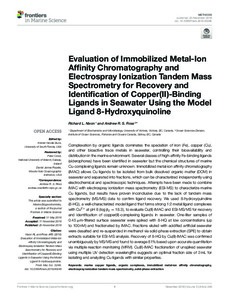Evaluation of Immobilized Metal-Ion Affinity Chromatography and Electrospray Ionization Tandem Mass Spectrometry for Recovery and Identification of Copper(II)-Binding Ligands in Seawater Using the Model Ligand 8-Hydroxyquinoline.

View/
Average rating
votes
Date
2016Author
Nixon, Richard L.
Ross, Andrew R.S
Metadata
Show full item recordAbstract
Complexation by organic ligands dominates the speciation of iron (Fe), copper (Cu), and other bioactive trace metals in seawater, controlling their bioavailability and distribution in the marine environment. Several classes of high-affinity Fe-binding ligands (siderophores) have been identified in seawater but the chemical structures of marine Cu-complexing ligands remain unknown. Immobilized metal-ion affinity chromatography (IMAC) allows Cu ligands to be isolated from bulk dissolved organic matter (DOM) in seawater and separated into fractions, which can be characterized independently using electrochemical and spectroscopic techniques. Attempts have been made to combine IMAC with electrospray ionization mass spectrometry (ESI-MS) to characterize marine Cu ligands, but results have proven inconclusive due to the lack of tandem mass spectrometry (MS/MS) data to confirm ligand recovery. We used 8-hydroxyquinoline (8-HQ), a well-characterized model ligand that forms strong 1:2 metal:liga.....
Journal
Frontiers in Marine ScienceVolume
3Issue
Article 246Page Range
10pp.Document Language
enBest Practice Type
Best PracticeStandard Operating Procedure
DOI Original
10.3389/fmars.2016.00246Citation
Nixon, R.L. and Ross, A.R.S. (2016) Evaluation ofImmobilizedMetal-Ion Affinity Chromatography and Electrospray Ionization Tandem Mass Spectrometry for Recovery and Identification ofCopper(II)-Binding Ligands ineawater using the model Ligand 8-Hydroxyquinoline. Frontiers in Marine Scoence, 3:246, 10pp.. DOI: 10.3389/fmars.2016.00246Collections
The following license files are associated with this item:
 Repository of community practices in Ocean Research, Applications and Data/Information Management
Repository of community practices in Ocean Research, Applications and Data/Information Management
